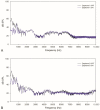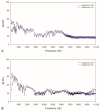Influence of the Noise-Canceling Technology on How We Hear Sounds
- PMID: 36011106
- PMCID: PMC9408706
- DOI: 10.3390/healthcare10081449
Influence of the Noise-Canceling Technology on How We Hear Sounds
Abstract
Purpose: This study explores the influence of the noise-canceling technology in commercial earphones on sound pressure levels and preferred listening levels in terms of hearing protection.
Materials and methods: Thirty individuals completed puretone audiometry and real-ear measurements to assess sound pressure levels at the level of the eardrum with and without the activation of the noise-canceling function. The Knowles Electronics Manikin for Acoustic Research was used to investigate the acoustic characteristics of two environmental sounds (bus and café). Two types of earphones (wireless and wired canal type) were utilized in the study.
Results: For both bus and café noises, in the low-frequency range, sound pressure levels were significantly decreased for all types of earphones when the noise-canceling function was turned on. The same results were observed for the whole frequency range. In terms of preferred listening levels, the wireless canal type and wired canal type earphones showed significant reduction in volume levels.
Conclusion: The findings of the study show that for both low- and whole frequency range, the use of noise-canceling function significantly decreases the sound pressure levels of the signal for all styles of earphones, suggesting a potential of the noise-canceling technology in hearing protection.
Keywords: hearing loss; noise; noise-induced hearing loss.
Conflict of interest statement
The authors declare no conflict of interest.
Figures
Similar articles
-
Effects of an Active Noise Control Technology Applied to Earphones on Preferred Listening Levels in Noisy Environments.J Audiol Otol. 2022 Jul;26(3):122-129. doi: 10.7874/jao.2021.00612. Epub 2022 Mar 24. J Audiol Otol. 2022. PMID: 35316868 Free PMC article.
-
Evaluation of Two Circumaural Earphones for Audiometry.Ear Hear. 2019 Jan/Feb;40(1):177-183. doi: 10.1097/AUD.0000000000000585. Ear Hear. 2019. PMID: 29742546
-
Output capabilities of personal music players and assessment of preferred listening levels of test subjects: outlining recommendations for preventing music-induced hearing loss.Laryngoscope. 2012 Nov;122(11):2549-56. doi: 10.1002/lary.23596. Epub 2012 Oct 11. Laryngoscope. 2012. PMID: 23060148
-
Pure-Tone Audiometry With Forward Pressure Level Calibration Leads to Clinically-Relevant Improvements in Test-Retest Reliability.Ear Hear. 2018 Sep/Oct;39(5):946-957. doi: 10.1097/AUD.0000000000000555. Ear Hear. 2018. PMID: 29470259
-
Music and Noise: Same or Different? What Our Body Tells Us.Front Psychol. 2019 Jun 25;10:1153. doi: 10.3389/fpsyg.2019.01153. eCollection 2019. Front Psychol. 2019. PMID: 31293465 Free PMC article. Review.
Cited by
-
Auditory environments influence the link between Autistic traits and quality of life.Sci Rep. 2025 Mar 27;15(1):10612. doi: 10.1038/s41598-025-94585-y. Sci Rep. 2025. PMID: 40148426 Free PMC article.
References
-
- World Health Organization Hearing Loss Due to Recreational Exposure to Loud Sounds: A Review. [(accessed on 20 February 2022)];2015 Available online: https://apps.who.int/iris/handle/10665/154589.
Grants and funding
LinkOut - more resources
Full Text Sources



